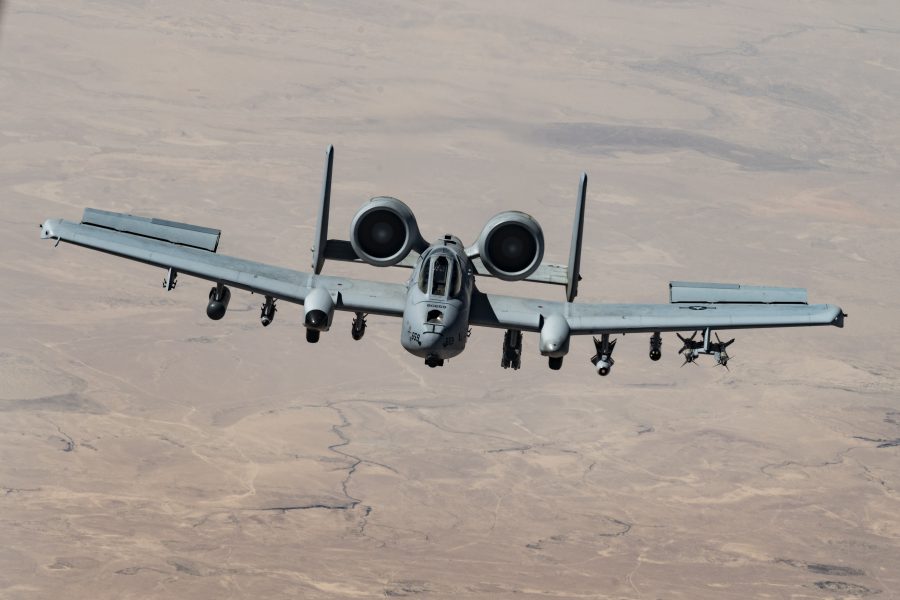Iran launched a large-scale attack against Israel on Oct. 1, just as additional U.S. Air Force assets rushed into the region.
A barrage of missiles was seen over Tel Aviv and other Israeli cities at around 7:30 p.m. local time. Just a few hours earlier, the White House warned that Iran was preparing a ballistic missile attack and said the U.S. would help defend Israel amid concerns that it would spark a full-scale regional war.
“Iran conducted a significant attack against Israel today, launching approximately 200 ballistic missiles targeting several locations in Israel,” Pentagon Press Secretary Air Force Maj. Gen. Patrick S. Ryder told reporters. “During the attack, the U.S. military coordinated closely with the Israeli Defense Forces to help defend Israel.” He said the majority of the missiles were intercepted.
Speaking at the White House, President Joe Biden said the “attack appears to have been defeated and ineffective.”
Iran vowed to respond to Israel’s forceful strikes on Lebanese Hezbollah, including one that killed the group’s leader, Hassan Nasrallah, on Sept. 27. Israel has also launched what it called a limited ground invasion of southern Lebanon against Hezbollah targets on Sept. 30. The U.S. has repeatedly pledged to defend Israel from Iran, which backs Hezbollah.
The USS Bulkeley and the USS Cole, which were operating in the Mediterranean Sea, fired a dozen interceptors, Ryder said. American aircraft and land-based air defense systems were not involved in any interceptions, he added. Ryder declined to say if U.S. aircraft provided any intelligence, surveillance, and reconnaissance of the missiles before or during the attack or if U.S. aircraft were involved in the mission. U.S. Air Force KC-135 Stratotanker aerial refueling aircraft flew over the Persian Gulf and Iraq, according to open source flight tracking data.
“We have a wide variety of ISR capabilities throughout the region to monitor and track potential aerial threats, to include aircraft that do that,” Ryder said.
The Pentagon has ordered three additional squadrons of fighter and attack aircraft to the Middle East. A squadron of A-10 Thunderbolt II attack aircraft has already arrived in the region, people familiar with the deployment told Air & Space Forces Magazine. On Oct. 1, U.S. Central Command said a squadron of F-16 Fighting Falcons and a squadron of F-15E Strike Eagles were also on their way to the Middle East.
U.S. fighter aircraft were ready if needed in case Iran launched drones and cruise missiles, a person familiar with the matter said. Fighters are effective against drones and cruise missiles, but have limited capability against ballistic missiles
“Fighter aircraft can perform a variety of missions, including taking down drones, taking down missiles—particular kinds of missiles—as well as providing ISR, electronic warfare, and those types of capabilities, so all of this comes together to provide us with options on how best to respond to any type of attack and to protect our forces,” Ryder said.
American F-15Es and F-16s helped Israel fend off a massive Iranian missile and drone attack in April by helping shoot down around 80 drones, part of an Iranian attack that also involved hundreds of cruise and ballistic missiles, totaling over 300 projectiles.
In that incident, Iran was retaliating for an April 1 attack by Israel on a facility in the Syrian capital of Damascus that killed members of the Islamic Revolutionary Guard Corps (IRGC).
The scope of the latest Iranian strikes was twice as large as April’s attack, Ryder said.
The U.S. Embassy in Jerusalem directed U.S. government employees and their family members to shelter in place, according to a State Department security alert. The embassy added that the U.S. government “reminds U.S. citizens of the continued need for caution and increased personal security awareness as security incidents, including mortar and rocket fire and unmanned aircraft system (UAS) intrusions, often take place without warning.”
The U.S. is increasing the number of warplanes in the region by temporarily extending the deployments of current units so that they overlap with the incoming forces. It conducted a similar move in April before Iran attacked Israel and in October after Hamas attacked Israel.
Before the latest deployments were announced, the U.S. already had squadrons of A-10s, F-16s, F-15Es, and F-22 fighters in the region. The Raptors were sent to the Middle East in August due to concerns about escalation in the region between Israel and Iran. The additional squadrons of A-10s, F-16s, and F-15Es will boost the U.S.’s airpower presence.
In addition to land-based aircraft ordered to the region, the USS Harry S. Truman aircraft carrier strike group is headed towards the Mediterranean Sea, and the Pentagon directed the USS Abraham Lincoln aircraft carrier, which was scheduled to head home, to remain in the Middle East. The Lincoln has an aircraft wing that includes F-35C Lighting II and F/A-18 Super Hornet fighters.
Before the attack, U.S. Secretary of Defense Lloyd J. Austin III spoke to Israeli Minister of Defense Yoav Gallant on Sept. 30 and “reaffirmed U.S. support for Israel’s right to defend itself against Iran, Lebanese Hezbollah, Hamas, the Houthis, and other Iran-backed terrorist organizations,” according to a Pentagon readout of the call.
Austin and Gallant spoke twice on Oct. 1, including after the attack. Biden and Vice President Kamala Harris monitored the event from the Situation Room, the White House said.
“We will consult with the Israelis on next steps in terms of the response and how to deal with what Iran has just done, and we will continue to monitor for further threats and attacks from Iran and its proxies,” National Security Advisor Jake Sullivan said. “Obviously, this is a significant escalation by Iran. … We have made clear that there will be consequences—severe consequences—for this attack, and we will work with Israel to make that the case.”


